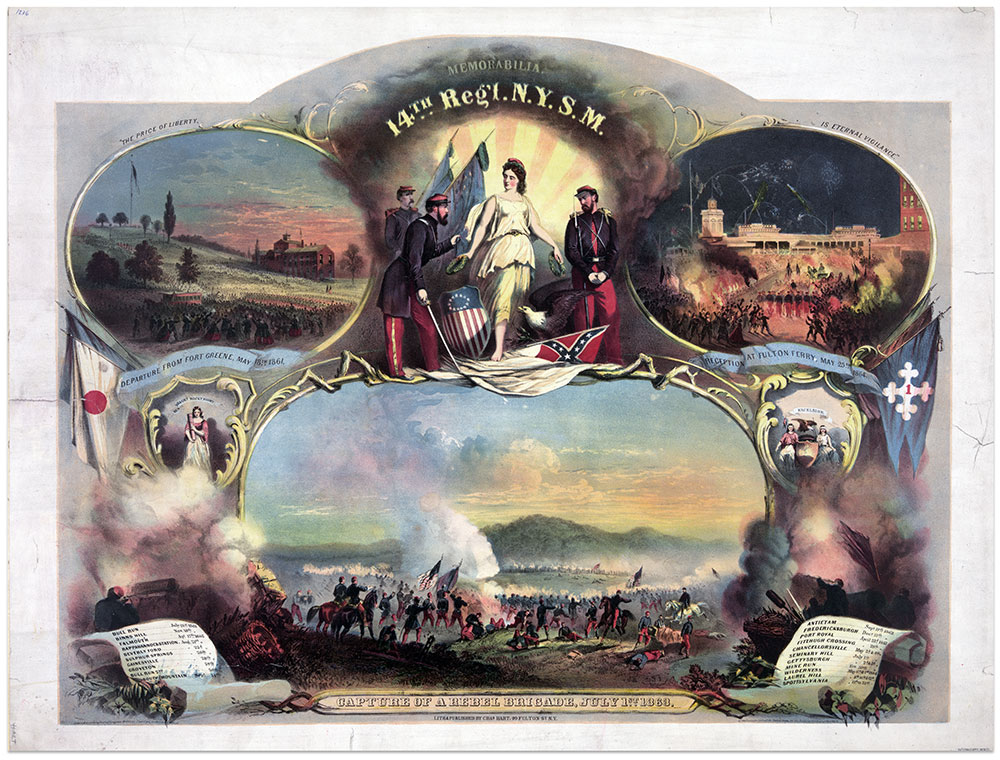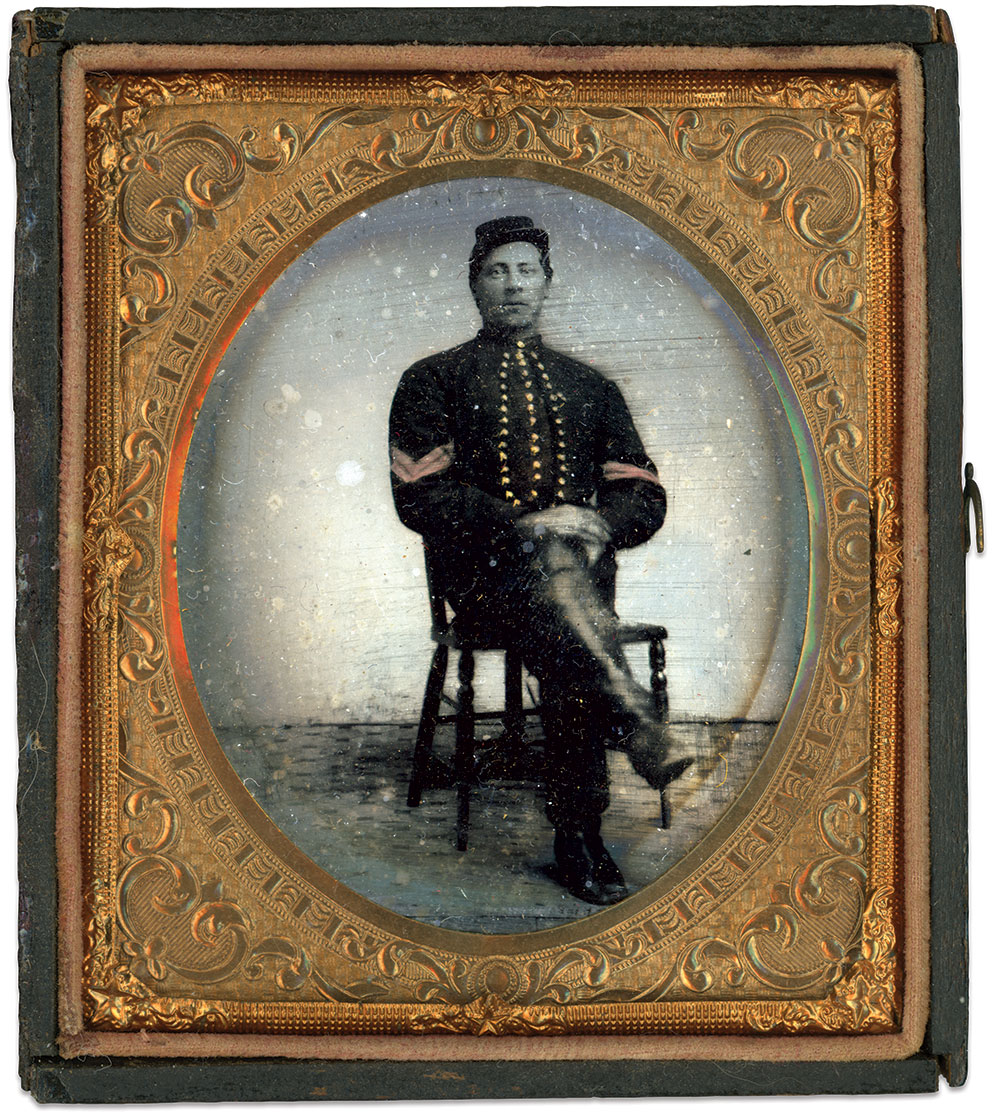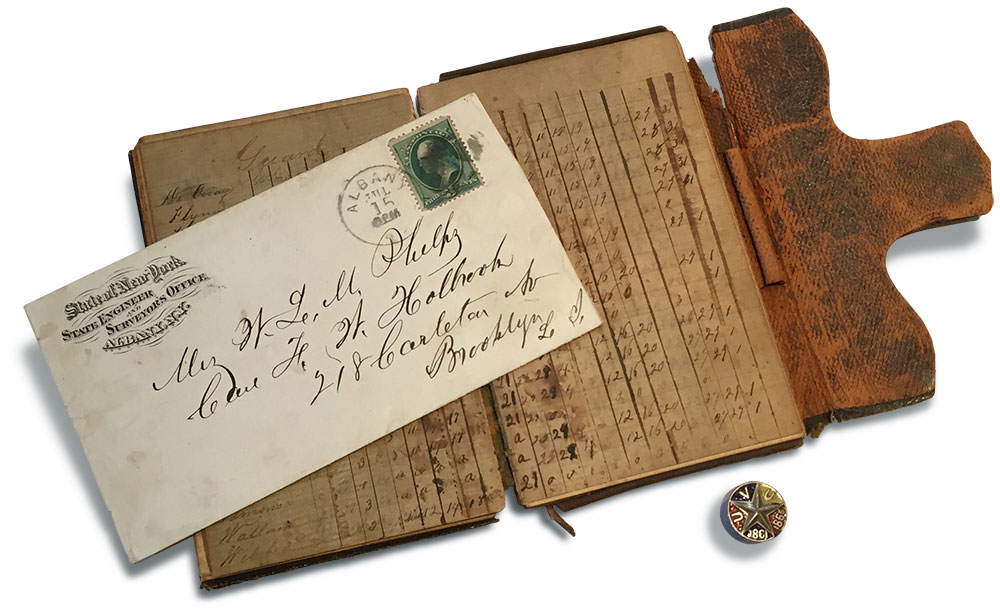By Ronald S. Coddington, with artifacts from the Ken Fleming Collection
Asa Adell Holbrook enjoyed telling stories about his war service. Even during his last days in a Soldiers’ Home in 1917, he spoke fondly of wearing the blue and red wool of the 14th Brooklyn Infantry. One of his favorite tales, noted a comrade at the Home, involved the change of the regiment’s designation from the 14th to the 84th New York Infantry.
The comrade shared Holbrook’s story in a newspaper: The rank and file of the 14th reacted with little interest or enthusiasm to the transition from State Militia to volunteers in the Union army in the summer of 1861. They were already soldiers, and the change had little impact on their daily existence. They expressed a similar nonchalance after the War Department changed their number from 14 to 84.
A few days later, however, after official orders and other documents arrived in camp addressed to the 84th New York Infantry, the Brooklyn boys revolted. “Horrors! The Fourteenth no more? They wouldn’t stand for it. ‘Give us our old number,’ they yelled, and frisked about the parade ground like lunatics.”

Their colonel, Alfred M. Wood, reminded them that they must obey orders and accept regulations. The soldiers refused to accept the change. “Finally, a compromise was effected. The War Department authorized that there be added to the volunteer name of the regiment, in parenthesis, ‘Or Fourteenth States Militia,’ and the revolt was at an end.”

Holbrook, a native New Yorker, lived in Brooklyn and worked as a clerk until the bombardment of Fort Sumter stirred him to action. He enlisted in the 14th on April 18, 1861, and joined the ranks of Company F. The regiment left the state about a month later for Washington, D.C., where it went on to fight in the First Battle of Bull Run and earn the nom de guerre Red-Legged Devils for the chasseur inspired uniform they adopted.
Another story that Holbrook liked to tell involved the uniforms. He explained how the 14th exploded in size from a small group to a full-sized regiment practically overnight following the wave of patriotism in the wake of Sumter. The state could not supply uniforms or weapons to the recruits, and so the citizens of Brooklyn established an emergency borough fund. Generous donations poured in, and the men were soon fully equipped for camp and campaign.

This story may help explain why Holbrook’s uniform survived the ravages of time. Pictured here, it includes the false red vest and buckle consistent with its manufacture. The coat sleeves are marked with sergeant’s chevrons that Holbrook earned in February 1863. The matching red cap is Grand Army of the Republic vintage and not directly connected to Holbrook. The uniform is likely the same one worn in this portrait of Holbrook as a corporal, a promotion he received in September 1862 following the battles of the Peninsula Campaign, Second Bull Run and Antietam.
Holbrook survived these engagements unscathed, but was not as fortunate during operations that culminated in the Battle of Chancellorsville. On April 29, 1863, the regiment’s second day of the campaign, the Brooklynites received orders to assist engineers in launching pontoons across the Rappahannock River in the face of punishing enemy fire.
“Instantly the Fourteenth responded,” recounted the regimental historian. “After stacking arms the right wing of the regiment manned the trucks bearing the boats and at a given signal, with a wild yell of defiance, the men rushed them toward the river bank. It was something like running an engine to a fire in old Brooklyn, at first—then vastly different. Once in the fire zone the volleys from the enemy staggered, almost checked the intrepid advance.”
The historian continued, “But only for a moment did the troopers hesitate. With men falling right and left, bullets spattering and flattening on the trucks and singing like swarms of angry bees about their ears, they gathered strength, pressed onward and, in the time taken in telling, reached the river and launched the boats.”
With the mission accomplished, two brother regiments, the 6th Wisconsin and 24th Michigan, sprinted from under cover to the boats, hopped in, and pulled oars for the opposite shore.
Holbrook suffered a wound at some point during the action. He and other injured Red-Legs were transported to Chatham Manor across the Rappahannock from Fredericksburg. The grand estate had been converted to a hospital, and suffered serious damage from its new occupants.

Meanwhile, word of Holbrook’s wound traveled to his family in Brooklyn. Holbrook’s father, Jonathan, went in search of his son. He visited an estimated 15 hospitals in Washington and other facilities until locating him at Chatham. The elder Holbrook reported that a bullet had struck his son in the right shoulder, and traveled down his arm and fractured a bone before exiting his elbow.
“I was five days with the 14th boys,” the senior Holbrook wrote home, “and found them mostly in first rate spirits, expecting and ready to have another brush with Johnny Secesh.”

Sergeant Holbrook did not get the chance to fight the Johnnies again. He remained out of commission until early 1864, and ended his service at the outset of the Overland Campaign when the regiment’s enlistment expired.
Holbrook returned to Brooklyn, and resided in the city and neighboring New Jersey until about 1879, when he moved to California and lived near Fresno with his wife, Sarah, and son, Asa. They lived in Raymond and Madera, where Holbrook tended bar in a saloon. In 1915, Holbrook entered the Soldier’s Home in the Sawtelle District of Los Angeles. He died two years later at age 74.
References: Times Union, Brooklyn, N.Y., May 19, 1863; The Los Angeles Times, July 15, 1917; The Brooklyn Eagle, July 22, 1917; Asa A. Holbrook military service records, National Archives, Washington, D.C.; The History of the Fighting Fourteenth.
Ronald S. Coddington is Editor and Publisher of MI.
SPREAD THE WORD: We encourage you to share this story on social media and elsewhere to educate and raise awareness. If you wish to use any image on this page for another purpose, please request permission.
LEARN MORE about Military Images, America’s only magazine dedicated to showcasing, interpreting and preserving Civil War portrait photography.
VISIT OUR STORE to subscribe, renew a subscription, and more.

